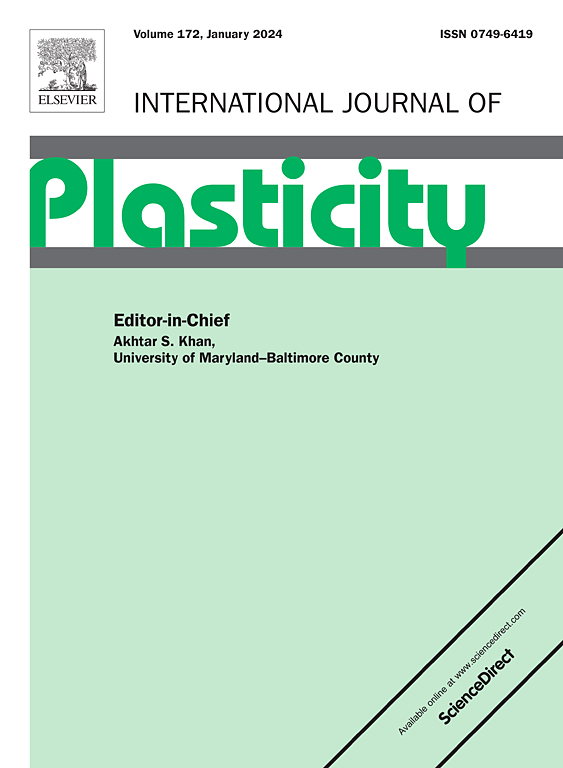Long-range internal stress from non-uniform geometrically necessary dislocations: A prediction method refined by dislocation dynamics simulations
IF 9.4
1区 材料科学
Q1 ENGINEERING, MECHANICAL
引用次数: 0
Abstract
The accumulation of geometrically necessary dislocations (GND) at grain boundaries is a primary source of long-range internal stress (LRIS) in polycrystals. The distribution of GNDs is typically inhomogeneous, and certain dislocation substructures with concentrated GNDs introduce a strong non-local effect. While many studies have explored the relationship between LRIS and the density of GNDs in polycrystals, few have discussed the influences of GND distribution patterns on LRIS calculations. This study employs dislocation dynamics (DD) simulations to investigate the LRIS of non-uniform GNDs confined within a grain boundary facet. First, the stress fields of three elementary types of GND bands with twist, tilt, and epitaxial dislocations are systematically analyzed using DD simulations. Considering the finite-size effect, scaling coefficients for recovering the LRIS around these GND bands are identified. Subsequently, non-uniform dislocation patterns are built to examine the distribution of LRIS at varying distances from grain boundary facets. In line with determining LRIS derived from an averaged surface GND density, an improved calculation method that accounts for the non-homogeneity of GNDs is developed. Finally, this method is applied to predict the LRIS of a set of GND facets with more complex dislocation patterns extracted from face-centered cubic grains. The predictions show good agreement with stress results computed by DD simulations, suggesting potential for further improvement of the dislocation density-based constitutive approach.
来自非均匀几何必要位错的长程内应力:通过位错动力学模拟改进的预测方法
几何必要位错(GND)在晶界的累积是多晶体中长程内应力(LRIS)的主要来源。GND 的分布通常是不均匀的,某些具有集中 GND 的位错子结构会带来强烈的非局部效应。虽然许多研究都探讨了 LRIS 与多晶体中 GND 密度之间的关系,但很少有人讨论 GND 分布模式对 LRIS 计算的影响。本研究采用位错动力学(DD)模拟来研究晶界面内非均匀 GND 的 LRIS。首先,利用位错模拟系统分析了具有扭曲、倾斜和外延位错的三种基本类型 GND 带的应力场。考虑到有限尺寸效应,确定了恢复这些 GND 带周围 LRIS 的缩放系数。随后,建立了非均匀位错模式,以检查 LRIS 在与晶界面的不同距离上的分布情况。在确定从平均表面 GND 密度得出的 LRIS 的同时,还开发了一种考虑到 GND 非均质性的改进计算方法。最后,该方法被应用于预测一组从面心立方晶粒中提取的具有更复杂位错模式的 GND 面的 LRIS。预测结果与 DD 模拟计算的应力结果显示出良好的一致性,表明基于位错密度的构成方法具有进一步改进的潜力。
本文章由计算机程序翻译,如有差异,请以英文原文为准。
求助全文
约1分钟内获得全文
求助全文
来源期刊

International Journal of Plasticity
工程技术-材料科学:综合
CiteScore
15.30
自引率
26.50%
发文量
256
审稿时长
46 days
期刊介绍:
International Journal of Plasticity aims to present original research encompassing all facets of plastic deformation, damage, and fracture behavior in both isotropic and anisotropic solids. This includes exploring the thermodynamics of plasticity and fracture, continuum theory, and macroscopic as well as microscopic phenomena.
Topics of interest span the plastic behavior of single crystals and polycrystalline metals, ceramics, rocks, soils, composites, nanocrystalline and microelectronics materials, shape memory alloys, ferroelectric ceramics, thin films, and polymers. Additionally, the journal covers plasticity aspects of failure and fracture mechanics. Contributions involving significant experimental, numerical, or theoretical advancements that enhance the understanding of the plastic behavior of solids are particularly valued. Papers addressing the modeling of finite nonlinear elastic deformation, bearing similarities to the modeling of plastic deformation, are also welcomed.
 求助内容:
求助内容: 应助结果提醒方式:
应助结果提醒方式:


